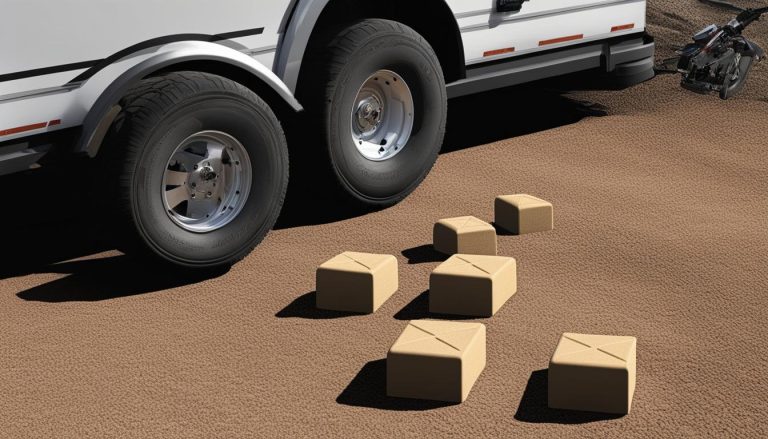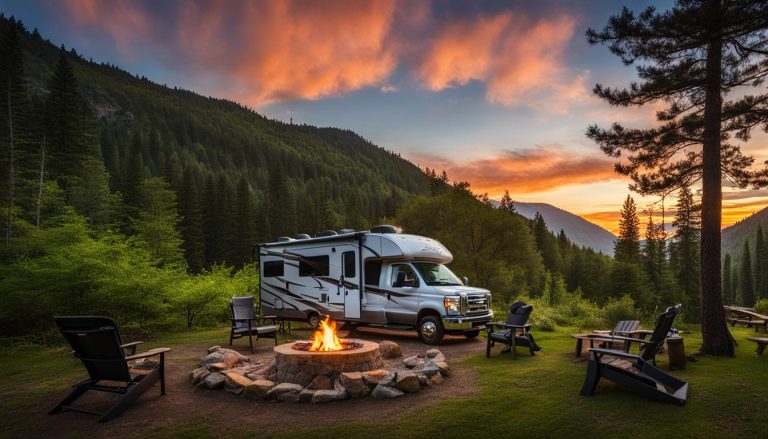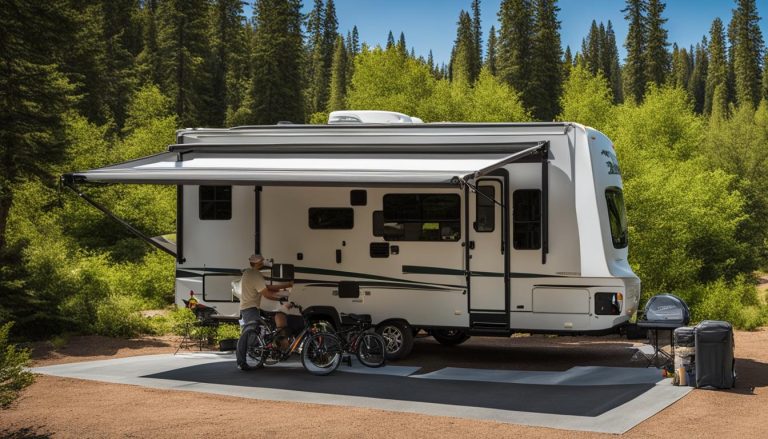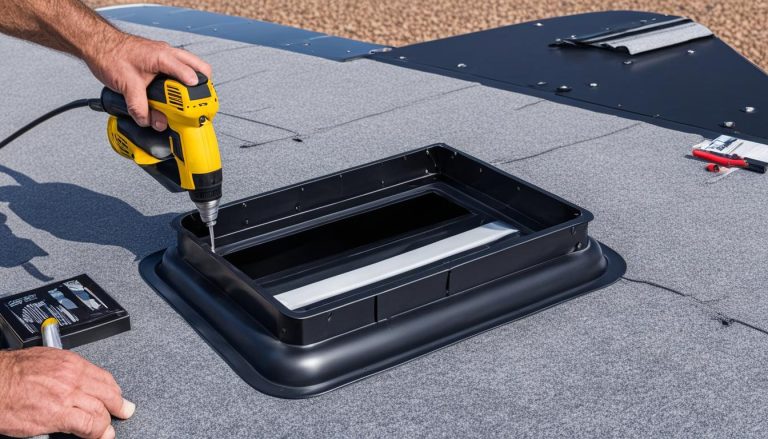Ready Your RV for Freezing Weather: Top Tips
gorvlifestyle.com and its partners may earn a commission if you purchase a product through one of our links
Winterizing your RV is essential when traveling to cold weather destinations where temperatures are below freezing. This involves emptying water tanks, draining the water heater and water lines, and disabling plumbing to prevent pipes from bursting. While some RVs may already be winterized, it’s important to check if your RV needs to be winterized before heading to colder climates. Using the right heater, insulating your RV properly, and preparing your pipes and tanks to prevent freezing are crucial steps for ensuring the safety and comfort of your RV in freezing weather.
Key Takeaways:
- Empty water tanks, drain the water heater and lines, and disable plumbing to prevent freezing.
- Check if your RV needs to be winterized before traveling to cold weather destinations.
- Choose the right heater for your RV, taking into account electricity availability and propane efficiency.
- Insulate your RV walls, windows, and doors, and consider using an RV skirt for additional insulation.
- Take precautions to prevent freezing of pipes and tanks, such as using a faucet to keep water moving and using heat tape on the water hose.
Decide Whether Your RV Needs to be Winterized
Winterizing your RV is an important step to protect it from freezing temperatures and potential damage. Before heading to colder destinations, it’s crucial to determine whether your RV has already been winterized or if it needs to be winterized. This will ensure the safety and longevity of your RV’s plumbing system and prevent any unwanted surprises during your winter travels.
If you’re unsure whether your RV has been winterized, here’s a simple way to find out. Begin by checking the RV’s water tanks, water lines, and water heater. If these are already drained and properly winterized, it’s a good indication that your RV is ready for freezing weather. However, if you find that the tanks are full, the lines have water in them, or the water heater hasn’t been drained, then your RV requires winterization.
You have two options for winterizing your RV: you can either do it yourself or have a professional RV company handle the process for you. If you choose to do it yourself, you’ll need to follow a few essential steps. Start by draining all water from your tanks, including the fresh water, gray water, and black water tanks. Next, empty your water heater and ensure that all water lines are completely cleared. Finally, disable your RV’s plumbing system by blowing out any remaining water using compressed air or by using RV antifreeze.
On the other hand, if you prefer to have a professional handle your RV’s winterization, many RV service centers offer winterization services. They have the expertise and equipment to ensure that your RV is properly winterized and ready for freezing temperatures. By entrusting the task to professionals, you can have peace of mind knowing that your RV is in good hands.
Before making a decision, take the temperature forecast of your destination into consideration. If you’re traveling to an area with consistently freezing temperatures, winterizing your RV is essential. However, if the temperatures are expected to remain above freezing, you may decide that winterization is not necessary. It’s always better to be safe than sorry and not take any chances with freezing conditions.
RV Winterization Checklist
Here’s a handy checklist to help you determine if your RV needs to be winterized:
- Water tanks: Are they drained?
- Water lines: Are they empty?
- Water heater: Is it properly drained?
- Plumbing system: Has it been disabled?
By following this checklist and assessing the current state of your RV’s water systems, you can make an informed decision about whether winterization is necessary.
| Signs that your RV needs winterization: | Signs that your RV may not need winterization: |
|---|---|
|
|
If you’re still unsure, it’s always a good idea to consult with an RV expert who can guide you based on your specific RV model and the climate conditions you’ll be facing.
Get the Right Heater
Finding the right heater for your RV is crucial for staying warm and comfortable in freezing weather. When choosing a heater, consider your power source and heating efficiency.
Electric Heater for RV
If you have access to electricity at your campsite, an electric heater is a cost-effective option. They are easy to use and provide consistent heat throughout your RV. Look for models with adjustable settings and safety features, such as overheating protection.
Portable Propane Heater for RV
For camping without an electric hookup, a portable propane heater is an excellent choice. These heaters are highly efficient and can quickly warm smaller spaces in your RV. Look for models with built-in safety features, like automatic shutoff and oxygen depletion sensors.
Remember that propane heaters consume fuel, so ensure you have enough propane on hand for your trip. Always follow the manufacturer’s instructions and never leave your heater unattended.
RV Built-In Furnace Maintenance
If your RV has a built-in furnace, regular maintenance is essential to keep it operating efficiently. Clean the furnace regularly and inspect the vents for any obstructions. Check the air filters and replace them as needed to ensure proper airflow and heating performance.
| Heater Type | Power Source | Heating Efficiency | Safety Features |
|---|---|---|---|
| Electric Heater | Electricity | Consistent heat | Adjustable settings, overheating protection |
| Portable Propane Heater | Propane | Quick and efficient | Automatic shutoff, oxygen depletion sensor |
| Built-In Furnace | Propane or Electricity | Part of RV heating system | Regular cleaning and maintenance |
Insulate Your RV Properly
Proper insulation is key to keeping your RV warm and reducing heat loss in freezing weather. By insulating the RV walls, windows, and doors, you can effectively retain heat and prevent drafts.
One important area to address is the RV slide outs. Placing foam board insulation underneath each slide can significantly reduce drafts and improve overall insulation.
Consider using an RV skirt. An RV skirt is a vinyl barrier that wraps around the bottom of your RV, creating an insulated air barrier. This not only helps keep the RV warmer but also prevents pipes from freezing. It’s a practical and effective way to enhance insulation during winter travel.
In addition to conventional insulation methods, you can also utilize a readily available resource: snow. Packing snow around the battery bays can provide natural insulation, further protecting critical components of your RV.
| Insulation Methods | Benefits |
|---|---|
| Insulating RV walls, windows, and doors | Retains heat and prevents drafts |
| Placing foam board insulation under RV slide outs | Reduces drafts and enhances insulation |
| Using an RV skirt | Creates an insulated air barrier and prevents freezing pipes |
| Using snow for insulation around battery bays | Natural insulation to protect critical components |
Proper insulation is an effective way to ensure the comfort and safety of your RV during winter travel. By implementing these insulation methods, you can maintain a cozy interior temperature and protect your RV from the harsh conditions.
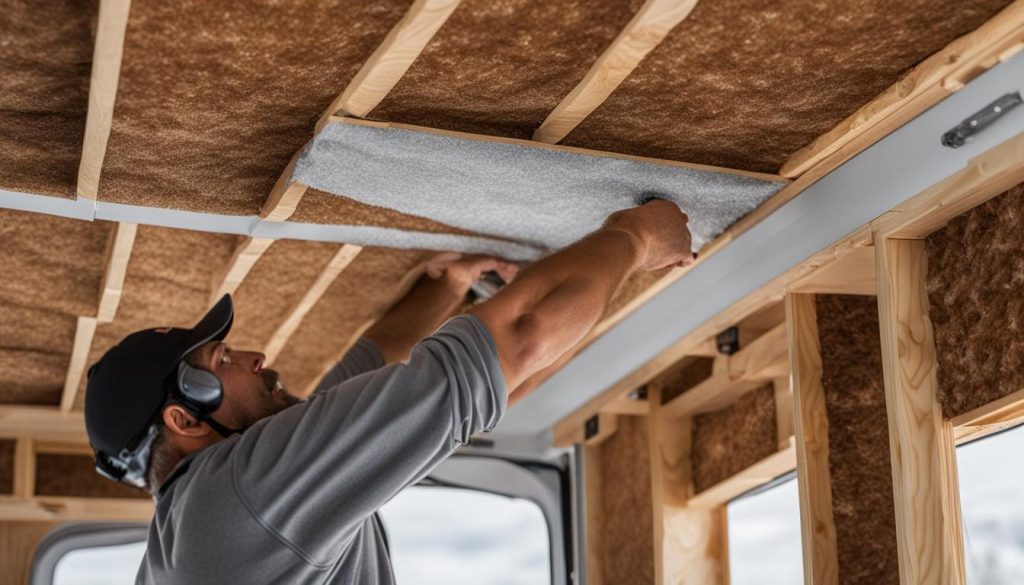
Prepare Your Pipes and Tanks to Prevent Freezing
Freezing pipes in your RV can lead to costly repairs and inconvenience during freezing weather. To protect your plumbing system from freezing, there are several precautionary measures you can take:
Keep a Faucet Slowly Running Overnight
One simple way to prevent pipes from freezing is to keep a faucet slowly running overnight. The movement of water through the pipes helps prevent freezing. Make sure to choose a faucet located away from the water source and open it just enough to allow a small, consistent flow.
Use Heat Tape
Another effective method to prevent frozen RV pipes is to use heat tape. Heat tape is an electrical heating element that can be wrapped around your RV water hose. It provides a consistent source of heat to keep the hose warm and prevent freezing. Make sure to follow the manufacturer’s instructions for proper installation and usage of heat tape.
Check Your Tires and Perform Regular Maintenance
Winter weather can affect the performance and safety of your RV tires. It’s essential to check your tires regularly and take appropriate measures to maintain their condition. Here are some tips for RV tire maintenance in freezing weather:
- Check the tire pressure frequently, as cold temperatures can cause tire pressure to drop.
- Inspect the tire tread depth regularly. Worn-out tires can reduce traction and increase the risk of accidents.
- Consider using snow chains or switching to snow tires for better grip and control in icy conditions.
Proper tire maintenance is crucial for safe and smooth winter RV travel.
Now that you know how to prevent RV pipe and tank freezing, you can ensure a hassle-free and comfortable experience during freezing weather. By taking these precautions, you’ll protect your plumbing system and enjoy a worry-free journey.
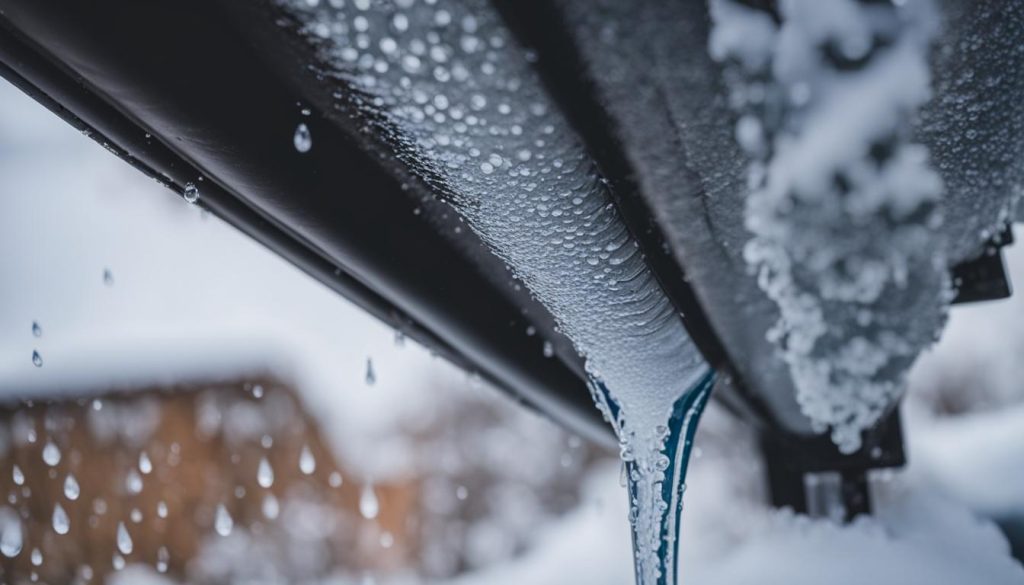
| Prevention Method | Description |
|---|---|
| Keep a Faucet Slowly Running Overnight | Allowing a small, consistent flow of water through a faucet can prevent pipes from freezing. |
| Use Heat Tape | Wrap heat tape around the RV water hose to provide a constant source of heat and prevent freezing. |
| Check Your Tires and Perform Regular Maintenance | Frequent tire checks, maintaining proper pressure and tread depth, and considering snow chains or snow tires can ensure safe driving in freezing weather. |
Pack the Right Gear
When embarking on a winter RV adventure, it’s crucial to pack the right gear to ensure your comfort and preparedness. The right equipment can make all the difference in keeping you warm, safe, and ready for any unexpected situations that may arise.
Stay Warm and Cozy
- Warm Clothing: Pack plenty of layers, including thermal underwear, fleece jackets, wool socks, and hats, to keep yourself insulated in the chilly weather.
- Waterproof and Windproof Gear: Invest in quality waterproof jackets, pants, and boots to stay dry and protected from the elements.
- Slippers: Bring a pair of cozy slippers or indoor shoes to keep your feet warm and comfortable inside the RV.
Be Prepared for Snowy Conditions
- Snow Shovel: A sturdy snow shovel is essential for clearing pathways and digging out your RV if it gets buried in snow.
- Ice Scraper: Keep an ice scraper handy to remove ice and frost from your RV windows and windshield.
- Tire Chains: If you’re planning to drive in snowy or icy conditions, consider carrying tire chains to improve traction and ensure safer travels.
Build an Emergency Kit
- RV Winter Emergency Kit: Prepare an emergency kit with essential items such as flashlights, batteries, a first aid kit, extra blankets, non-perishable food, and water.
- Weather and Road Condition Apps: Stay updated on weather and road conditions by downloading reliable apps that provide real-time information, ensuring a smooth and safe journey.
Don’t forget to stock up on necessary toiletries such as lip balm and sunscreen for protection against the harsh winter elements. With the right gear, you’ll be well-equipped to tackle winter RV adventures with confidence and comfort.
Keep Cold Air from Coming in the Windows
Properly insulating your RV’s windows is essential for preventing cold air infiltration and maintaining a warm interior. By taking a few simple steps, you can minimize heat loss and maximize comfort during freezing weather.
Closing your RV’s shades and curtains is an effective way to create an air gap and reduce heat loss. This barrier helps to keep the cold air from seeping through the windows and maintains a warmer temperature inside the RV.
An additional measure you can take is insulating your RV windows with plastic film. This thin film is easy to install and provides a protective barrier against cold air infiltration. It shrinks when heated, creating a tight seal over the window and preventing drafts.
Here is a step-by-step guide on how to insulate your RV windows with plastic film:
- Clean the window thoroughly and make sure it is completely dry.
- Cut the plastic film slightly larger than the window size.
- Apply the double-sided tape along the edges of the window frame.
- Press the plastic film onto the tape, ensuring a secure attachment.
- Use a hairdryer to heat the film, causing it to shrink and form a tight seal.
- Trim any excess film for a neat and tidy appearance.
By insulating your RV windows, you can significantly reduce heat loss and improve overall energy efficiency. This helps to create a cozy and comfortable living space, even in the coldest temperatures.
Check the Campground Schedule
Planning ahead is important when traveling in freezing weather, as many campgrounds close during winter months. It’s crucial to check the availability of campgrounds and RV parks in your destination and make reservations in advance.
Even if a campground appears closed, it’s worth calling to inquire about day-by-day camping options. Some campgrounds may be open but not officially, allowing for camping on a case-by-case basis. Checking the campground schedule ensures that you have a safe and accessible place for RV parking during winter trips.
Additionally, checking road conditions and driving carefully in snowy conditions is vital for a smooth and safe winter RV experience.
FAQ
How can I prepare my RV for freezing weather?
To prepare your RV for freezing weather, you should empty water tanks, drain the water heater and water lines, and disable plumbing. It’s important to winterize your RV to prevent frozen pipes and other potential damage.
How do I know if my RV needs to be winterized?
Before traveling to colder destinations, check if your RV has already been winterized. If not, it’s crucial to winterize it yourself or have a professional RV company do it for you. Check the temperature forecast of your destination to determine if winterization is necessary.
What type of heater should I use in my RV?
Finding the right heater for your RV is important. If you have access to electricity, an electric heater is a cost-effective option. If you’re camping without electricity, a small, portable propane heater is recommended. Keep your RV’s built-in furnace clean and free of debris for proper airflow.
How can I ensure proper insulation in my RV?
Proper insulation is key in keeping your RV warm during freezing weather. Insulate the walls, windows, and doors of your RV to prevent drafts. Foam board insulation underneath slide outs can also reduce drafts. Consider using an RV skirt for additional insulation.
How can I prevent my RV pipes from freezing?
Preventing freezing pipes is crucial to avoid costly repairs. Keep a faucet slowly running overnight to prevent freezing. You can also use heat tape wrapped around the water hose. Proper tire maintenance is also important for winter RV travel.
What gear should I pack for winter RV travel?
When traveling in freezing weather, pack warm clothing, waterproof and windproof gear, slippers, a snow shovel, and an ice scraper. Vent insulator pillows can help retain heat, and weather and road condition apps provide valuable information. Additionally, stock up on necessary toiletries and have emergency items such as tire chains and canned food.
How can I keep cold air from coming in through the windows of my RV?
Closing shades and curtains can help create an air gap and minimize heat loss. Insulating windows with plastic film is also effective in reducing heat loss. Properly insulated windows contribute to overall heat retention inside the RV during freezing weather.
What should I consider when planning a winter RV trip?
When planning a winter RV trip, check the availability of campgrounds and RV parks in your destination. Make reservations in advance and inquire about day-by-day camping options if the campground appears closed. Also, check road conditions and drive carefully in snowy conditions for a safe and smooth winter RV experience.

